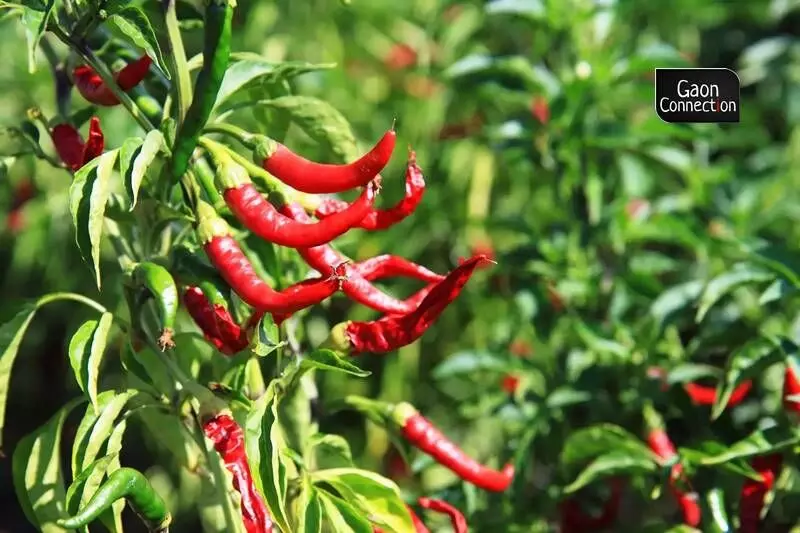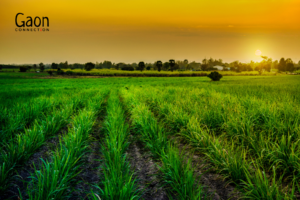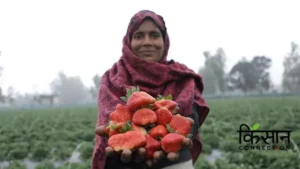Varanasi, Uttar Pradesh
There is excitement amongst the chilly farming communities in Uttar Pradesh. Varanasi-based Indian Institute of Vegetable Research has developed a new kind of paprika chilly. It is called VPBC-535, but is better known as Kashi Sindoori.
VPBC-535 has the potential of adding a beautiful paprika red to lipsticks. The chilly, developed by the research institute under the Indian Council of Agricultural Research, is not as much for its taste as it is for the value it will bring to the cosmetics industry.
This hybrid variety of VPBC-535 chilly is an incentive for farmers to cultivate it side by side with the edible chillies that do not fetch such a high price in the market.
“We have been conducting trials on chillies for many years and have been sharing its findings with the farmers,” Tushar Kanti Behera, director of IVVR, told Gaon Connection. According to him, this is for the first time that the Kashi Sindoori or Paprika is being cultivated in the country.
“The chilly turns a bright red when it ripens. It has medicinal properties. Its oleoresin (a flavourful extract) is used for its medicinal qualities and rich colour which can be used in cosmetics, such as lipsticks. The natural pigment can revolutionise the industry,” he added. The scientist also pointed out how the natural colour could save millions of people who use cosmetics that contain synthetic and toxic chemicals.
Also Read: Banana stems become the unlikely protectors for the fiery bhut jolokia chilli
The Indian beauty and personal care market is the eighth largest in the world with a total value of US$ 15 billion and is growing at 10 per cent. The market is expected to double by 2030 with skin care and cosmetics driving this growth. Increasing demand for herbal cosmetic products among Indian consumers is also creating a wide growth opportunity for manufacturers.

A unit to extract colour from the Kashi Sindoori/paprika chillies would help the farmers.
Forty per cent of the farmers in Media village in Mirzapur district, have been cultivating chillies for generations. Not just here, chilli cultivation is also big in Barabanki, Varanasi, Sonbhadra and Chandauli districts. Thousands of quintals are exported to Dubai, Oman, Qatar, Germany and the United Kingdom, besides some neighbouring countries.
But it is not such a profitable crop, say the farmers. “The cost of seeds, the irrigation, pesticides, fertilisers, labour, etc., leaves us with little profit,” Pappu Singh, a chilly farmer from Media, told Gaon Connection.
Pappu Singh has begun cultivation of the Kashi Sindoori chillies on a trial basis with the seeds he got from IIVR. Apart from some farmers in Uttar Pradesh, the variety of Kashi Sindoori has been distributed to selected farmers in Karnataka, Kerala, Tamil Nadu, and Puducherry, informed Behera.
Breaking down the cost of a 50-kg bag of the regular chillies, Pappu Singh said, “For this bag of chillies, Rs 200 has gone into harvesting and Rs 40 into transportation. If I add the cost of irrigation, fertilisers and my own efforts, it leaves me with barely any profit,” he pointed out.
Also Read: Green chilli farmers in the red
The farmer felt that the cultivation of the Kashi Sindoori chillies could be the way forward for farmers to earn a lot of money. According to Pappu Singh, the regular chillies sell up to Rs30 a kg, but can plummet to Rs 10 a kg when there is a glut.
The Kashi Sindoori on the other hand can sell up to Rs 90 a kg, he said. But for that to happen the farmers should have a contract that will assure them their entire produce is bought by big companies.

“If that happens the efforts of Prime Minister Narendra Modi to double the earnings of the farmers will be realised,” Pappu Singh said.
Similar concerns were voiced by Babloo, a young farmer from Lohta village in Varanasi district. “While the traditional chillies do reasonably well in the beginning, once the mandis are flooded with them, the prices fall,” he complained. “But the Kashi Sindoori holds out hope for thousands of farmers like me. We only need to be put in touch with companies that manufacture cosmetics,” the farmer added.
A unit to extract colour from the Kashi Sindoori/paprika chillies would help the farmers. “Once the unit is set up the government could encourage and support farmers to grow this chilly,” Babloo said.
“While I cultivate the Kashi Sindoori for its flavour and colour, a few people have taken it from me to use as a food colouring agent. The benefits will be manifold if units to extract the chilly’s properties are set up,” Pappu Singh reiterated. “If this is done, and the benefits are clearly seen, many more farmers will step forward to cultivate this variety,” he added.
“If there is official support and encouragement from the government, the cultivation of Kashi Sindoori could get a huge fillip,” Jyoti Kumar Singh, district horticulture inspector of Varanasi, told Gaon Connection.
How to cultivate the Kashi Sindoori
Developed by ICAR-IIVR, Varanasi, the chilly is called VPBC-535. It is non-spicy and contains high amounts of oleoresin (15 per cent). It can yield up to 150 quintals per hectare. The regular chillies might yield a bit more as more fertilisers are used in them. About 400-500 grams of seeds are needed per hectare for the Kashi Sindoori.
* The Kashi Sindoori can be cultivated in both rabi and kharif seasons.
* Farmers who plan to scientifically cultivate this variety should prepare the nursery in the months of July/August.
* It is recommended that 30 days after sowing of the seeds, the saplings should be transplanted at a distance of 45 cms, with each row being at a distance of 60 cms.
* While the field is being prepared, about 20-30 tonnes per hectare of compost or cow dung fertiliser should be used.
* The chillies need 120 kgs of nitrogen, 80 kgs of phosphorus and 80 kgs of potash per hectare.
For detailed information and instructions, farmers can get in touch with the Kisan Vigyan Kendra, or the horticulture department in their districts.


















